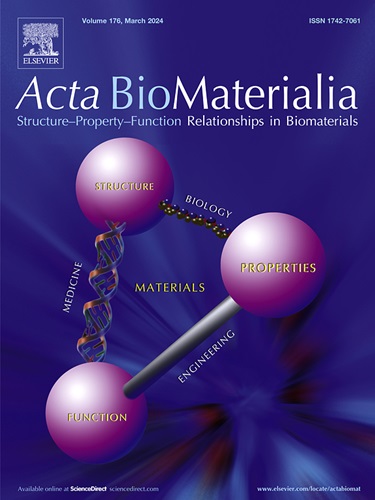Esterase-responsive kartogenin composite hydrogel microspheres boost nucleus pulposus regeneration in intervertebral disc degeneration
IF 9.4
1区 医学
Q1 ENGINEERING, BIOMEDICAL
引用次数: 0
Abstract
Cell transplantation for nucleus pulposus (NP) regeneration represents a promising strategy for intervertebral disc degeneration (IVDD). Nonetheless, the hostile microenvironment within the degenerated intervertebral discs, characterized by redox imbalance and elevated mechanical pressure, poses risks of low cell survival and inadequate cell colonization for efficient NP regeneration. To address these challenges, we developed a biomimetic, esterase-responsive composite hydrogel microsphere (GHKM) for cell delivery, consisting of gelatin methacrylate (GelMA) mixed with HAMA-KGN, a conjugate of hyaluronic acid methacrylate (HAMA) and the small heterocyclic molecule kartogenin (KGN) via ester bonds. GHKM mimic the NP extracellular matrix (ECM), providing essential adhesion and mechanical support for cell proliferation, while facilitating cellular adaptation to the adverse microenvironment through the esterase-responsive release of KGN. Furthermore, GHKM exhibit favorable biocompatibility and promote or protect ECM synthesis by nucleus pulposus cells (NPCs) under both normal and inflammatory conditions. Transcriptomic sequencing analysis indicates a correlation between enhanced ECM synthesis and enrichment of antioxidant-related pathways. Subsequent cellular biological studies reveal that GHKM can also reduce reactive oxygen species production within the inflammatory milieu. The underlying mechanism of its protective effect on matrix metabolism may involve the activation of nuclear factor erythroid 2-related factor 2 (NRF2) and the upregulation of downstream antioxidant enzymes. In vivo implantation of NPCs-laden GHKM into rat tail nuclectomy models for 4 and 8 weeks preserved disc height, structure, and biological function, with histological analysis confirming NP regeneration. These findings present GHKM as a promising, synergistic transplantation strategy for NP regeneration in IVDD.
Statement of significance
This study introduces an esterase-responsive gelatin methacrylate/hyaluronic acid methacrylate-kartogenin composite hydrogel microsphere (GHKM) system, aimed at mimicing the extracellular matrix (ECM) of the nucleus pulposus (NP) to address the pressing challenge of intervertebral disc degeneration (IVDD). These microspheres offer an innovative solution for cell transplantation therapy by simultaneously addressing two critical barriers: the harsh microenvironment of the degenerated disc and the need for sustained therapeutic effects. GHKM provide mechanical support, enhance cell survival, and adapt dynamically to adverse conditions through esterase-responsive release of kartogenin (KGN), a multifunctional molecule with chondrogenic, anti-inflammatory, and antioxidative properties. This study will not only interest researchers focused on regenerative medicine and biomaterials but also inspire new directions for tackling complex degenerative diseases.

酯酶反应型Kartogenin复合水凝胶微球促进椎间盘退变髓核再生。
髓核细胞移植(NP)再生是治疗椎间盘退变(IVDD)的一种很有前途的策略。然而,退变椎间盘内的恶劣微环境,以氧化还原不平衡和机械压力升高为特征,存在细胞存活率低和细胞定植不足的风险,无法实现有效的NP再生。为了解决这些挑战,我们开发了一种用于细胞递送的仿生、酯酶响应的复合水凝胶微球(GHKM),由甲基丙烯酸明胶(GelMA)与甲基丙烯酸透明质酸(HAMA)和小杂环分子kartogenin (KGN)通过酯键结合而成。GHKM模拟NP细胞外基质(ECM),为细胞增殖提供必要的粘附和机械支持,同时通过酯酶响应性释放KGN促进细胞适应不利的微环境。此外,在正常和炎症条件下,GHKM表现出良好的生物相容性,并促进或保护髓核细胞(NPCs)合成ECM。转录组测序分析表明,增强的ECM合成与抗氧化相关途径的富集之间存在相关性。随后的细胞生物学研究表明,GHKM还可以减少炎症环境中活性氧的产生。其对基质代谢保护作用的潜在机制可能与核因子红细胞2相关因子2 (NRF2)的激活和下游抗氧化酶的上调有关。在大鼠尾核切除模型中植入含有npc的GHKM 4周和8周后,椎间盘高度、结构和生物学功能得以保留,组织学分析证实了NP再生。这些发现表明,GHKM是IVDD患者NP再生的一种有希望的协同移植策略。意义声明:本研究介绍了一种酯酶反应性的甲基丙烯酸明胶/甲基丙烯酸透明质酸-kartogenin复合水凝胶微球(GHKM)系统,旨在模拟髓核(NP)的细胞外基质(ECM),以解决椎间盘退变(IVDD)的紧迫挑战。这些微球为细胞移植治疗提供了一种创新的解决方案,同时解决了两个关键障碍:退变椎间盘的恶劣微环境和持续治疗效果的需要。GHKM提供机械支持,提高细胞存活率,并通过酯酶响应释放kartogenin (KGN)动态适应不利条件,KGN是一种具有软骨形成、抗炎和抗氧化特性的多功能分子。这项研究不仅将引起再生医学和生物材料研究人员的兴趣,而且将为解决复杂的退行性疾病提供新的方向。
本文章由计算机程序翻译,如有差异,请以英文原文为准。
求助全文
约1分钟内获得全文
求助全文
来源期刊

Acta Biomaterialia
工程技术-材料科学:生物材料
CiteScore
16.80
自引率
3.10%
发文量
776
审稿时长
30 days
期刊介绍:
Acta Biomaterialia is a monthly peer-reviewed scientific journal published by Elsevier. The journal was established in January 2005. The editor-in-chief is W.R. Wagner (University of Pittsburgh). The journal covers research in biomaterials science, including the interrelationship of biomaterial structure and function from macroscale to nanoscale. Topical coverage includes biomedical and biocompatible materials.
 求助内容:
求助内容: 应助结果提醒方式:
应助结果提醒方式:


